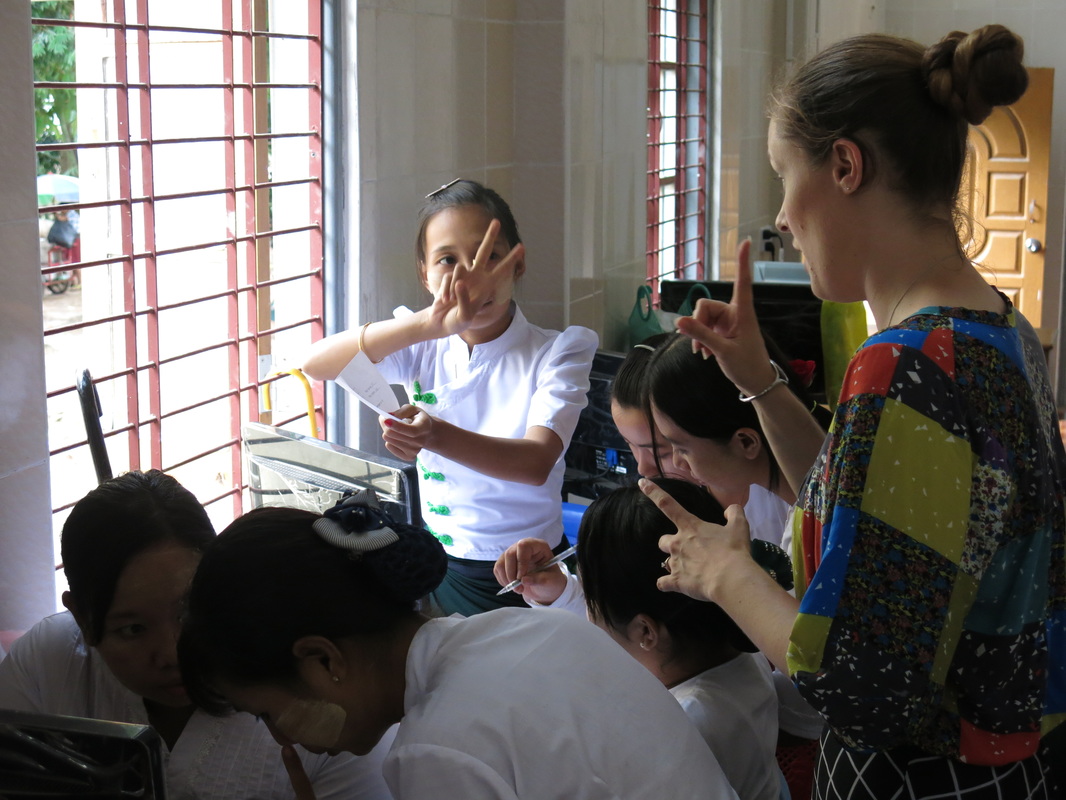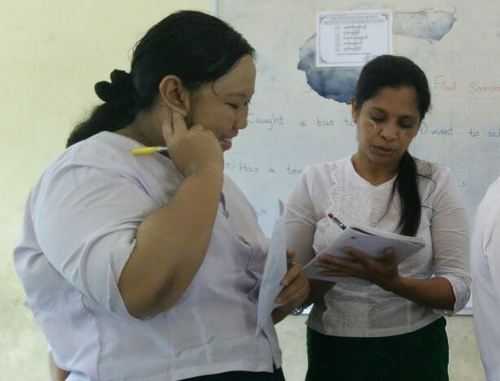|
After my first day with my new students, I realized that I would not be able to use the exact material that I had developed. Whilst this wasn’t a huge surprise to me, I was slightly taken aback at quite how low the level of English was. I decided that I should incorporate training wherever possible by asking the teachers to think critically about how they could use or adapt the activities in their own classrooms. This critical thinking didn’t need to be done in English and therefore was more of an exercise in implementing active learning within the classroom than a test of knowledge. I covered a broad range of topics with my 11 pupils. The syllabus was broader than any typical speaking and listening course because there were things that I wanted to cover with regards to teacher training that needed that broader focus. Timelines for example only really work if you are teaching tenses! I choose to focus on the past perfect, which, I will admit seems like a strange choice for beginners who struggle to remember to add the S at the end of the third person singular. However, I knew that I wanted to exemplify the usage of Concept Checking Questions as well as the timeline approach. I also knew that the grammar of these ladies was much higher than their comparative ease of speaking. Some of the topics that we covered were requests from the teachers themselves, such as used to. This became a popular lesson as it required the ladies to draw a storyboard featuring 8 events or actions; 4 which they used to do, and 4 which they still do now. This personalized the instruction and is something that is easy to replicate in a class of 40 students. Each person explained to a partner what the drawing showed and whether they used to do the activity depicted or if it started in the past and continued in the present. For this explanation, each student spoke to 5 other people. This is an easy way to get students to practice their oral language skills. Of course, in a student-centered classroom, feedback to the teacher is an essential component. This ensures that students are focusing on the given task and it gives students confidence that their teacher is a useful feature of the class! Often students dislike speaking to each other as they fear they will encounter mistakes, or that it’s not as worthwhile as speaking to the teacher who is clearly the fount of all knowledge. I disagree with this view. Whilst I feel that the teacher must provide adequate and useful follow up activities in which the teacher is engaging with the student dialogue, students must use one another as a resource in the classroom. One day, we were practicing finger correction when we received a visit from the librarian monk and the head monk! Their timing was amusing because I am certain that they didn’t have a clue what we were doing, nor could they fathom a reason for why we might be doing such an odd looking thing. It was great though, because the following week, one of my students came in and said that she had used finger correction in her classroom! In ESL, there is a very well debated question of fluency or accuracy when teaching or learning a language. The current school of thought is that fluency trumps accuracy, provided the accuracy is such that a speaker is able to be understood. Therefore, it stands to reason that we should not jump on mistakes that our students make and by doing so, potentially cripple their willingness to participate in class. On the other hand, we do not wish for our learners to get fossilized errors embedded into their vocabulary. We also know that our five senses work much better when we employ more of them into the learning process. Therefore, one effective way to enable our students to self correct is to use our fingers to indicate a missing word. More often than not, the student will find this visual aid jogs their memory and they are able to add in the missing word or contract the two words that they have just used with minimal disruption to their flow of language. We do a lot of task-based learning based on real-life contexts. It is really important to be able to anchor the new language in a context. Most learners are familiar with such concepts as going to market or giving directions, they simply need the vocabulary in the target language. Therefore, it works well to set the classroom up as a town centre with all of the amenities that one might need: the bank, the pagoda, the church, the supermarket, and so on. Each student stands next to a building in town and then asks for directions to a new place. The beauty of this model is that the directions change depending on where you are standing in the room, and so the learners must use both their English language and their common sense as they guide each other around the classroom. I was pleased to learn that the teachers were familiar with the concepts of student-centered teaching and active learning from the beginning. The problem is implementing it in a 40 student classroom with limited resources. I hope that even if the total concept is unrealistic to achieve in such a setting, many of the components can be used to enhance the learning experience of Myanmar children. There was no final written test for the course as it didn’t seem appropriate given the desired outcome is the usage of the techniques in a real-life classroom. Instead, each teacher had 20 minutes to present one of the topics that we had covered in class and show that they knew how to use the styles of instruction from the course. This was successful in general, and although some of the weaker ladies struggled to use exclusively English, I was able to see that they had paid attention and thought critically about the exercises and how they could fit them into their classes. Chloe Smith NEH Coordinator and Teacher Trainer
Comments
|
This section will not be visible in live published website. Below are your current settings: Current Number Of Columns are = 3 Expand Posts Area = 1 Gap/Space Between Posts = 20px Blog Post Style = card Use of custom card colors instead of default colors = Blog Post Card Background Color = current color Blog Post Card Shadow Color = current color Blog Post Card Border Color = current color Publish the website and visit your blog page to see the results |
|
© New Education Highway 2024
Except where otherwise noted, content on this site is licensed under a Creative Commons Attribution 4.0 International License. |



